‘Signs of Life’
Friday, June 30th, 2017Coral Morphologic makes a cameo in the new Arcade Fire music video, ‘Signs of Life.’ The vid follows two paranormal investigators through the weird world(s) of South Florida.
Coral Morphologic makes a cameo in the new Arcade Fire music video, ‘Signs of Life.’ The vid follows two paranormal investigators through the weird world(s) of South Florida.

Thanks to everyone that attended the Coral Orgy this past Friday, February 24th at the New World Center on Miami Beach. Coral Orgy was a site-specific audiovisual collaboration by Coral Morphologic and Animal Collective on the cosmic secrets behind the sexual reproduction of corals. Coral Morphologic proposes that unlocking the secrets of coral reproduction is a culminating achievement in humankind’s quest for colonization of planet Earth, and a first step towards restoring a healthy biosphere.
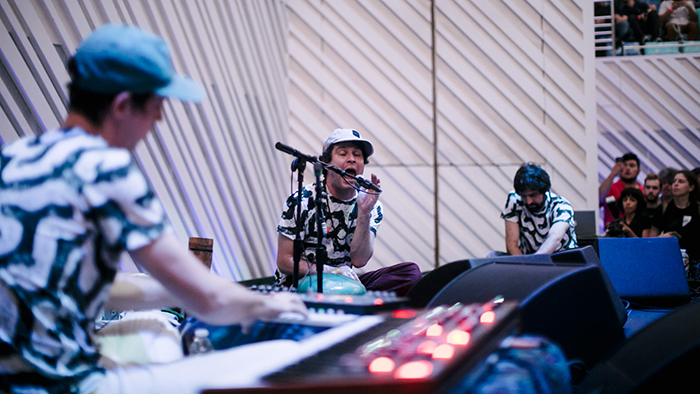
Animal Collective performed an hour of new music inspired by the reefs while Coral Morphologic projections painted a cosmic world of fluorescent coral inside the Frank Gehry-designed concert hall.
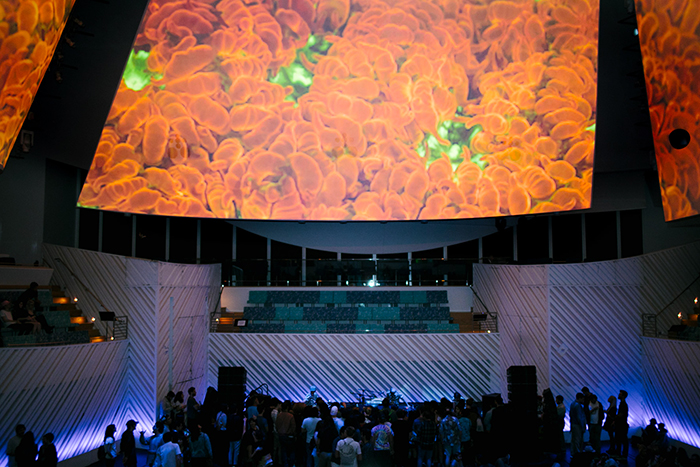
We are grateful to have been able to include footage of one of the first predicted stony coral spawns in captivity from Project Coral at the Horniman Museum. This advancement in coral reproduction (led by aquarist Jamie Craggs) is evidence that humanity is finally crossing this all-important milestone at just the critical juncture when the world’s coral reefs are ailing most. We are proud to support the work of SECORE and the Coral Restoration Foundation, and were thrilled to be able to display their footage of corals spawning in nature across the New World Center’s 7,000 square foot video projection wall in SoundScape Park prior to the main event.
On February 24th 2017, Coral Morphologic presents Coral Orgy, a collaborative site specific performance with Animal Collective at the Frank Gehry-designed New World Center on Miami Beach. Coral Orgy is an audiovisual meditation on the secrets behind the sexual reproduction of corals, and an invocation towards the human quest of unlocking them. Animal Collective will perform an hour of new music inspired by the reefs while Coral Morphologic projects a cosmic world of fluorescent coral inside the Frank Gehry-designed New World Center performance using its twelve 4k projectors to map all five of Gehry’s sails. Before the performance, Coral Morphologic films will play outside on the 7,000 square foot projection wall in SoundScape Park.
Tickets on sale Tuesday, February 7th via https://coralorgy.frontgatetickets.com
Through this event, Coral Morphologic and Animal Collective aim to highlight the groundbreaking scientific work done on coral reproduction by the non-profits Coral Restoration Foundation (USA), SECORE (GER), and Project Coral (UK).
We are psyched to make an appearance in a new episode of Hamilton Morris’ Viceland TV show, Hamilton’s Pharmacopeia. Colin & Hamilton dive on Miami’s Cosmic Reef in search of a marine sponge known to contain psychedelic compounds. Watch via Viceland.

Members of the Gables Earth Club with the 300 gallon Coral Morphologic reef aquarium post-installation in 2015.
In September 2015 the lease ended on our first lab warehouse and we had to downsize our systems. We decided to donate our 300 gallon glass reef aquarium system–complete with all the gear, rocks, and corals–to the students of Coral Gables Senior High School in order to plant the seeds of reefkeeping and coral aquaculture in the next generation. The lab is maintained by student members of the Gables Earth Club, and overseen by faculty science teacher Mr. Eric Molina. We believe that no other activity accomplishes the goals of STEAM (Science, Technology, Engineering, Art, Math) better than reef keeping, and includes an added R for Responsibility (STREAM). While math and science can be taught from textbooks, the holistic act of coral aquaculture requires hands-on attention and care. We’ve observed firsthand how these students understood the assignment and really have gone above and beyond to care for these delicate creatures.

The aquarium in 2016.

We are psyched to share Rarities, an album of 10 soundtracks compiling the music from our early short films and Natural History outtakes. Rarities was written, produced, and mixed by Coral Morphologic and mastered by Adam McDaniel at Drop of Sun Studios, Asheville NC. The album features CM photography / design and is available in a very-limited 12″ x 12″ ‘Screen Print Edition‘ depicting Ernst Haeckel’s ‘Brain Stone’ illustration in fluorescent inks. The 5 prints were hand-screened by Colin on artist Robert Rauschenberg’s Captiva Island printing press during the ‘Rising Waters II’ residency. Stream Rarities via Spotify and pick up the album in digital and print editions @ https://coralmorphologic.bandcamp.com/album/rarities
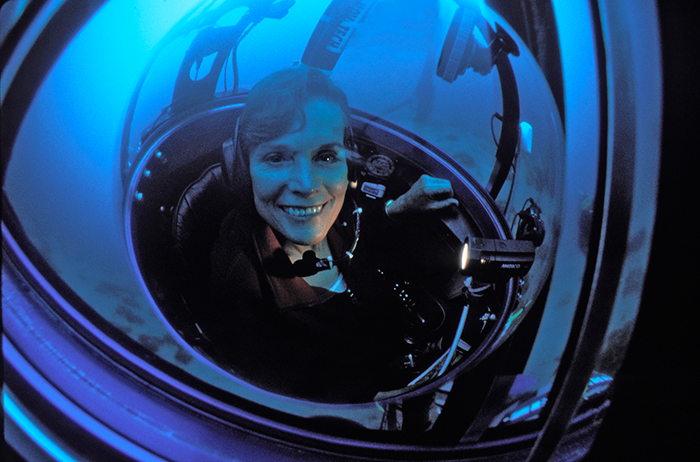
Coral Morphologic is proud to announce a partnership with Mission Blue, an alliance of conservationists founded by Dr. Sylvia Earle, with the shared goal of exploring the ocean and engendering empathy for Earth’s marine life. By joining the Mission Blue network, we look forward to helping advance Mission Blue’s goals, including increasing marine protected areas (Hope Spots) around the globe 20% by 2020, developing sustainable fisheries, and reducing oceanic pollution. Coral Morphologic is committed to educating the public and building new paradigms around the value of the ocean and its essential role as Earth’s life support system.
Please explore Mission Blue’s website and watch the eponymous 2015 documentary about Dr. Earle “Mission Blue” on Netflix.
We are pleased to share the release of a series of apparel recycled from post-consumer plastic bottles, in collaboration with our friends at Waterlust. The ‘Cosmic Coral’ line features Coral Morphologic zoanthid, man o war, and flower anemone prints, and are now available to purchase from the Waterlust online shop. The leggings are 86% RPET (recycled polyester), 14% lycra, giving 10 post-consumer plastic bottles a positive future. Additionally, they are printed using dye-sublimation, an environmentally friendly process which uses no water and minimizes waste. 10% of profits go toward our efforts to research and document Miami’s imperiled coral reefs.


Robert Rauschenberg’s Fish House on Captiva Island, Florida.
Colin recently took part in a 15-day residency at the former home and studio of artist Robert Rauschenberg on Captiva Island, Florida. The residency was the second edition of the ‘Rising Waters Confab’, which aims to “spark new thinking and to influence civic will toward finding and spreading solutions to the rising waters of climate change. This movement is a collective effort guided by a diverse array of artists and writers in a spirit of collaboration with scientists, activists, advocates, philanthropists, and island dwellers.”
Colin spent his time on Captiva screen printing a collection of new work on Rauschenberg’s press, taking photographs of the island’s breathtaking views overlooking the Gulf of Mexico, and working with artists, scientists, architects, and writers on interdisciplinary approaches to tackling climate change. Read the residencies’ blog here.
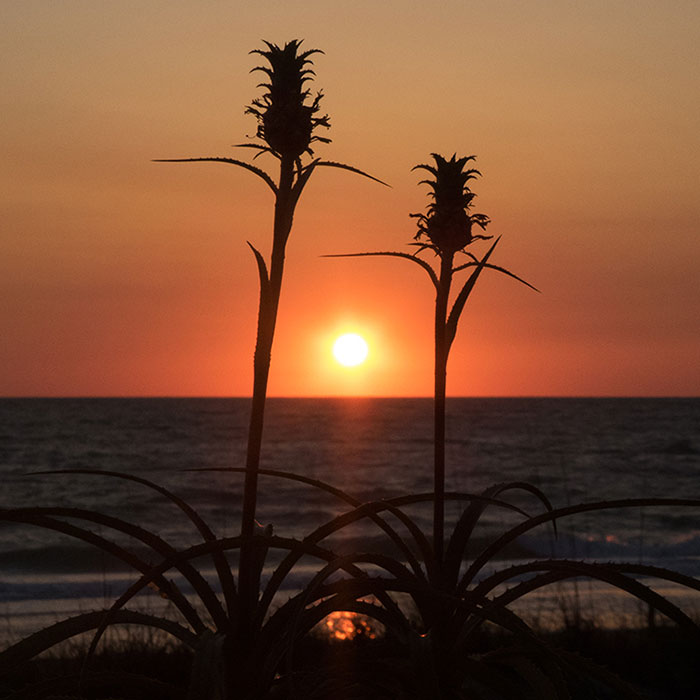
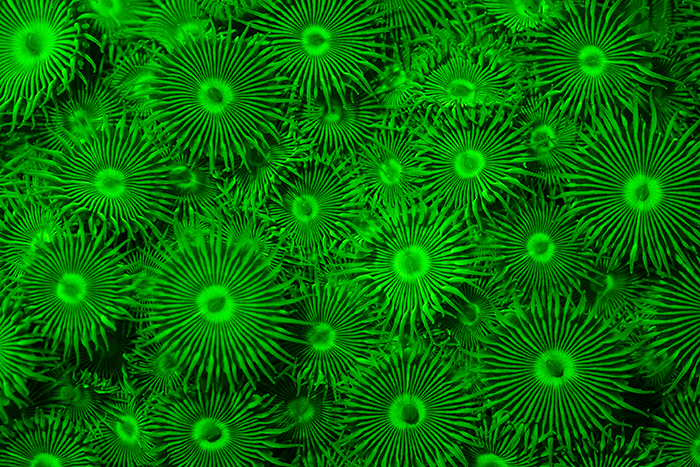
These Palythoa sp. zoantharians contain a remarkably potent chemical, palytoxin, proven to selectively destroy cancerous cells.
Several years ago we were excited to report that our survey of Zoantharian soft corals from South Florida had resulted in the identification of several undescribed species. Today, we are even more excited to report that one of these Palythoa species zoantharians, collected off the PortMiami seawall, contains an extremely powerful compound with proven anti-cancer properties. Coral Biome, our partners in Europe, have officially received a patent for the chemical’s extraction and application in the treatment of cancer and other serious diseases. From Coral Biome’s inception in 2011 in Marseilles, France, we have been assisting them in the collection, identification, and aquaculture of soft corals that produce medically-valuable chemicals, a process known as ‘bioprospecting’.
It’s a treat to share Flower Garden Banks, an Animal Collective x Coral Morphologic collaboration featuring “Michael, Remember (Jam May 12, 2015)”, the first warm-up jam for Animal Collective upon getting together to practice for the first time in a year and a half. It features Avey Tare, Panda Bear, and Geologist, and was recorded at Drop of Sun Studios in Asheville, NC. The accompanying underwater video was recorded in July 2014 within the Flower Garden Banks National Marine Sanctuary over two nights by Colin, with additional camera and lighting by Deakin and Geologist of Animal Collective. The raw jam and video were later shared, and the resulting video was edited by Jared.
The Flower Garden Banks are located about 100 miles offshore Galveston, Texas in the Gulf of Mexico and are the northernmost coral reef formations in the continental United States. The reef begins at about 60’ deep and is characterized by massive brain coral heads and a lack of branching or soft corals. The corals were filmed with special blue wavelength lights and filters that capture the natural fluorescence of the colonies. While the evolutionary purpose that this fluorescence serves corals is still not fully understood, the directed application of the corals’ fluorescent proteins by geneticists was awarded the Nobel Prize in Chemistry in 2008 by serving to accelerate (and literally illuminate) the field of genetics and biochemistry.

Today we release an album we’ve been compiling for years – Flannel Beach: The Doom Years, a mixtape featuring South Floridian bands spanning the years of 2004-2012. The album is available in digital, 12″ vinyl, and cassette editions via our online store & IRL @ Gramps Friday, September the 25th. Coral City & Natural History Redux are screening before Rick Guerre goes live, followed by a special Guy Harvey reunion set. Read more about Flannel Beach here via the Miami New Times and here via The Creators Project. Thank You to the musicians of Flannel Beach, Sound Nutrition, who co-produced the LP, Jorge Gonzalez Graupera, who mastered it, and Brian Butler, the artist behind the swampy album artwork.
We are proud to have filmed the corals of the Miami Coral Rescue Mission for a new BBC three-episode television series on the Atlantic Ocean titled Atlantic: The Wildest Ocean on Earth. Watch the Coral Morphologic-shot coral fluorescence sequence above, which features in the series’ third episode, ‘From Heaven to Hell’, airing August 13th on BBC Two in the UK.
A thorny mud crab (Micropanope urinator) scuttles along the face of a Fire Coral (Millepora alcicornis) encrusted barnacle range.
During the production of Natural History Redux we naturally had several outtakes… enjoy!
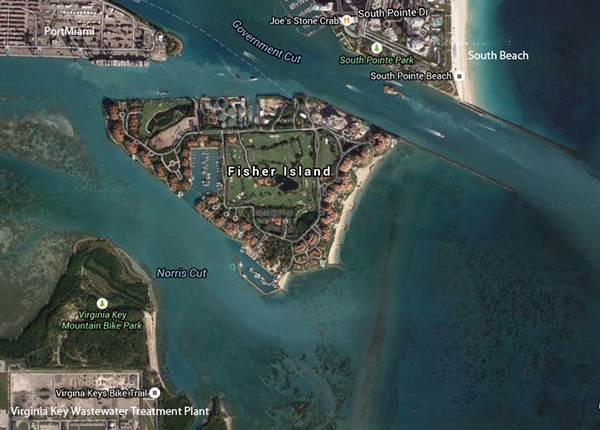
Fisher Island, Government & Norris Cuts.
A Nursery Solution:
The Deep Dredge of Government Cut has caused significant coral stress and mortality on the corals and reefs in and around Miami… including wide areas that the Army Corps predicted would not be affected. In particular, the dredging at PortMiami has resulted in vast sediment plumes that arc around the south-side of Fisher Island and out through Norris Cut where federally protected elkhorn corals are suffering.
As mitigation against this coral die-off and stress, Coral Morphologic proposes the construction of an ‘urban coral research nursery’ along the edge of South Pointe Park where the public can be directly engaged with the marine ecosystem of Miami. This coral nursery will be built primarily to house and grow fragments from the variety of Acropora corals living around Fisher Island. The coral nursery will be a proactive mitigation response to a shameful coral transplantation effort on Fisher Island and the siltation-related mortality of coral around Miami.
In order to test the resilience of these Fisher Island Acropora corals, it is imperative that these colonies are grown and cloned into as many individual colonies as possible. Not only will this allow for exhaustive in-situ research projects, but it will also result in additional fragments useful for restoring reefs around Miami after the Deep Dredge is completed. Because the Fisher Island Acropora corals are so unique, the only way to properly test their resilience is to fragment them repeatedly over time to create enough cloned test subjects. Because the hybrid Acropora corals are not conferred federal protection, their clones are ideally suited for life in educational public aquarium reef displays around the globe where they will become fluorescent icons of adaptation and resilience for both Miami and coral-kind.
Coral Morphologic proposes that such a coral nursery should be deployed just inside Government Cut along South Pointe Park which provides ideal water conditions for growing all of the Miami’s ‘urban coral’ species; especially the Fisher Island Acropora corals. The South Pointe coral nursery will provide coral biologists with a low-cost, easily-accessible platform in which to pursue unique coral research projects that only Miami affords. Close access to land-based electrical and internet infrastructure will allow an array of tools that offshore nurseries can’t count on such as 24/7 live streaming underwater web cameras, flow meters, and water chemistry monitoring probes. A continuous stream of open-access data on the water quality moving into and out of Biscayne Bay with every tide will be necessary to provide the City with the most accurate information possible in which to predict future sea level rise and pollution. Furthermore, the addition of interactive signage will engage and educate citizens and tourists about the overlooked marine ecology of Miami Beach.
This coral nursery project will cost in the tens of thousands of dollars and require a long list of permits and permissions from agencies at the city, county, state, and federal level. While the levels of bureaucratic protection for corals are meant to be helpful, it also presents considerable roadblocks for those wishing to cultivate them for restoration and research. While an initial $10,000 Accelerator Grant from the Miami Foundation has kickstarted the planning process in earnest, we will be requiring more grant funding and donations to complete the project. We look forward to updating everyone on this project as we move forward to grow the rare and resilient ‘urban corals’ of Miami and Fisher Island!
Fisher Island Hybrid Fused Staghorn Coral (elkhorn morphotype) pre-dredge/ mid-dredge health survey.
The most remarkable aspect of the health of the corals growing on Fisher Island, is the success story of two hybrid fused-staghorn corals (Acropora prolifera) that live along its shorelines. The story of the first hybrid coral is well documented through the TEDxMIA talk Colin conducted in 2011. This hybrid coral appears to be much more palmate in its growth morphology which typically means that its mother was a staghorn and its father an elkhorn. This coral has proven to be the most remarkably resilient of the Fisher Island Acropora corals. While its growth has been somewhat slow, it has never demonstrated any evidence of significant die-off, white pox, or bleaching. It also features significant amounts of fluorescent green proteins which may confer it with an adaptive advantage over its non-fluorescent parent species.
However, there is another equally unusual hybrid fused-staghorn coral living on Fisher Island that we’ve also been observing since 2009. And it demonstrates a much more compact branching staghorn morphology, indicating that its mother was likely an elkhorn coral and its father a staghorn.

Aerial view of Biscayne Bay and Government Cut. Fisher Island is encircled in the Army Corps’ Deep Dredge silt 4/14/15.
Over the past eighteen months, the Army Corps of Engineers’ Deep Dredge of PortMiami has continuously released dirty water throughout Biscayne Bay and onto our surrounding reefs. The dredging will continue through at least August 2015. Over the course of the Dredge project we have observed levels of suspended silt far beyond what is environmentally acceptable or healthy in a coral reef environment. Silt that is directly causing coral mortality in areas far beyond where the Army Corps predicted.
One of Coral Morphologic’s biggest ongoing concerns during the Deep Dredge has been the well-being of a hybrid fused-staghorn coral (Acropora prolifera) colonizing the Fisher Island side of Government Cut. This coral is what kickstarted our interest in documenting the extent of coral colonization within Miami’s coastal waterways, and was the subject of Colin’s 2011 TEDxMIA talk ‘A Hybrid Future – The Corals of Miami‘. The concerns we expressed to the State of Florida about this coral is ultimately what led them to provide us with permits to rescue corals from the dredging far offshore… but not for the hybrid itself (or any other corals on Fisher Island).
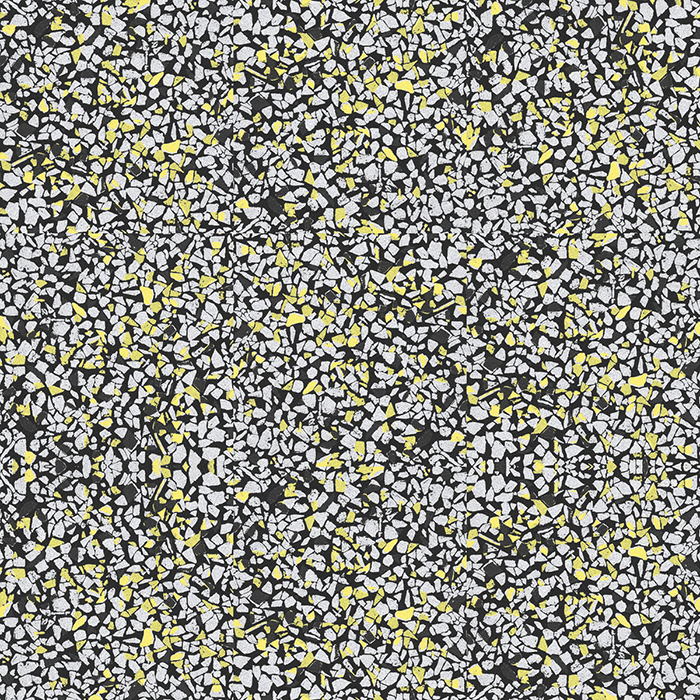
We’re psyched to share a soundtrack of ours (‘Strand’) is part of Other Electricities‘ new “call and response” LP, where Emile Milgrim and T. Wheeler Castillo’s Floridian field recordings are included in original and remixed forms. Stream Archival Feedback via Spotify and pick up the album in digital and vinyl / deluxe editions @ https://other-electricities.bandcamp.com/album/archival-feedback

Coral Morphologic TV debuted this past weekend at the Sagamore Hotel, on Miami Beach. The site-specific installation was commissioned by the Red Bull Guest House, and consists of 4 vinyl-wrapped outdoor televisions each playing the Coral Morphologic films Natural History Redux & Circumtropical on loop.
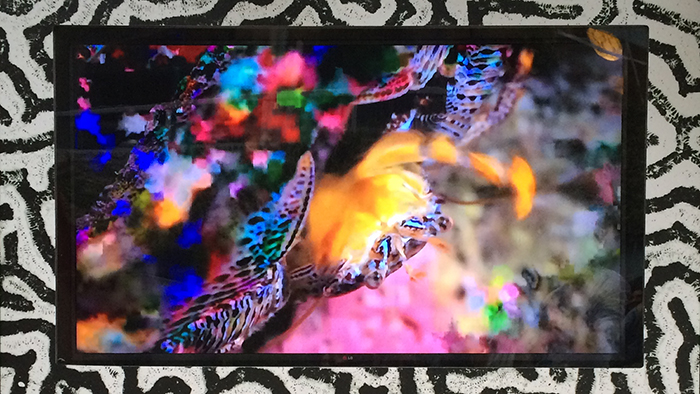
Last month, our film Natural History Redux screened at the Imagine Science Film Festival held at New York University’s campus in Abu Dhabi. Abu Dhabi is located along the Arabian/ Persian Gulf as one of the coastal Emirates in the United Arab Emirates. Colin was asked to speak on a panel regarding the future of global water resources and the importance that art/ science has to play in bringing these issues into public awareness. However, he also had the opportunity to explore the unique marine habitat in the area.
We are very psyched to share Coral City, a half-hour documentary accompanying the Coral Morphologic cover story in last August’s VICE Magazine. The movie, directed by John McSwain and shot by Jake Burghart of VICE Media, documents our efforts to highlight the urban corals of Miami as resilient pioneers adapting to a rapidly changing world.

The ‘Coral Therapy’ Design Curio at Design Miami/ 2014.
For Design Miami/ 2014, we were honored to be asked to create a conceptual room in which we debuted Coral Therapy, a 360-degree virtual reality film experienced via the Oculus Rift. When viewing Coral Therapy, the viewer is enveloped by fluorescent corals and sea anemones; much like being inside a virtual planetarium theater. Coral Therapy is designed to convey a virtual out-of-body experience in which the viewer is transported to a tranquil tropical reef in outer-space. An original ambient score enhances the cosmic coral perspective while accentuating the peaceful and relaxing experience.

‘Coral Therapy’ in action via Oculus Rift VR.
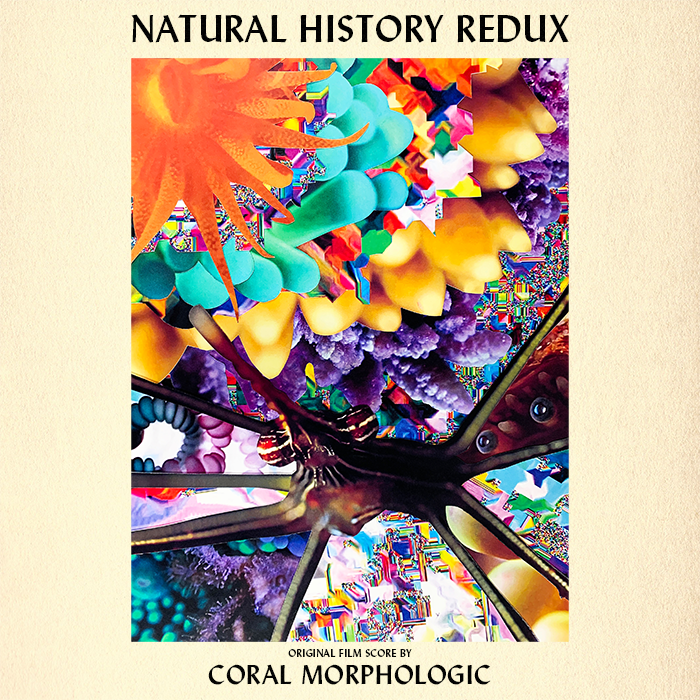
We’re grateful to present the original film score for Natural History Redux, collecting the original versions of NHR‘s 23 short film soundtracks. The NHR score was written, produced, and mixed by Coral Morphologic (with the exception of ‘Man O War’ – written, produced, and mixed by Geologist) and mastered by Adam McDaniel at Drop of Sun Studios, Asheville NC. The album is available in a 18″ x 24″ ‘Collage Poster Edition‘ featuring a collage by David Scott Myers (Red Wizard Collage), with design and photography by CM. Stream the original film score for Natural History Redux via Spotify and pick up the album in digital and print editions @ https://coralmorphologic.bandcamp.com/album/natural-history-redux-original-film-score
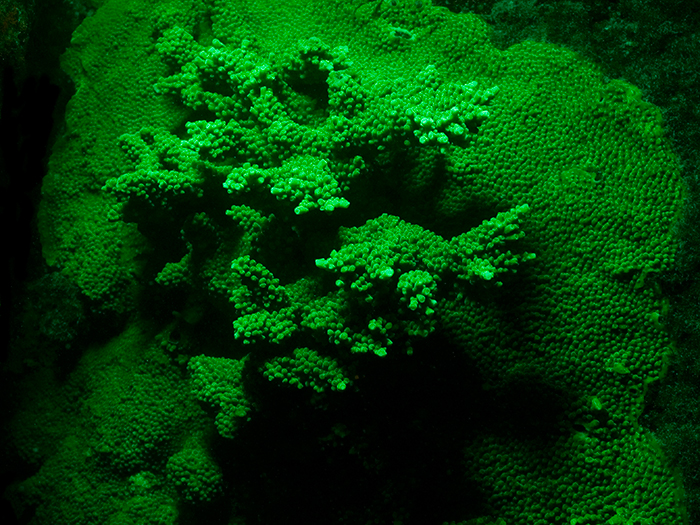
A fluorescence photograph of the hybrid fused staghorn coral.
It was the discovery of a hybrid fused staghorn coral living on a granite boulder beneath the shadows of a luxury condo that initially sparked our interest in the resilient corals that are taking advantage of Miami’s underwater infrastructure. Colin first presented this coral to the public for TEDxMIA in 2011 in a talk titled ‘A Hybrid Future – The Corals of Miami’. But with the Army Corps’ Deep Dredge of Government Cut happening just a stones throw from where this coral lives, we have been particularly concerned about the health of this coral. Not only are Miami’s corals being inundated with excessive dredge silt, they’re also dealing with the same water conditions that have induced an alarming percentage of corals to bleach across South Florida’s reefs.
As we last reported, a combination of hot weather and sunny days in summer 2014 has resulted in very a bad year for coral bleaching in South Florida. In this dispatch, we surveyed the natural reef just offshore Fisher Island here in Miami. To make matters worse, the water is exceptionally silty from the Army Corps’ dredging of Government Cut less than half a mile away. The water is 10-15 feet deep here, and nearly all of the coral heads were bleached. However, the most alarming condition we observed was the prevalence of black band disease infecting many of the brain corals. While healthy corals can usually recover from a bleaching episode, a coral suffering from both bleaching and black band disease will probably die. As evidenced from the video, the dredge silt has settled on the corals, and is likely a culprit in causing this black band disease outbreak. Currently, the dredge ships are operating just outside the mouth of Government Cut jetties, resulting in plumes of silt that smother corals on the natural reefs in every direction.

Fortunately, we have seen the water temperatures steadily decrease since the start of September, so we are hopeful that the bleached corals throughout South Florida will begin to recover soon. However, up here in Miami with the Deep Dredge ongoing, our corals may be too stressed out, diseased, or smothered to survive. We will be monitoring the situation closely, and will continue to update as necessary.
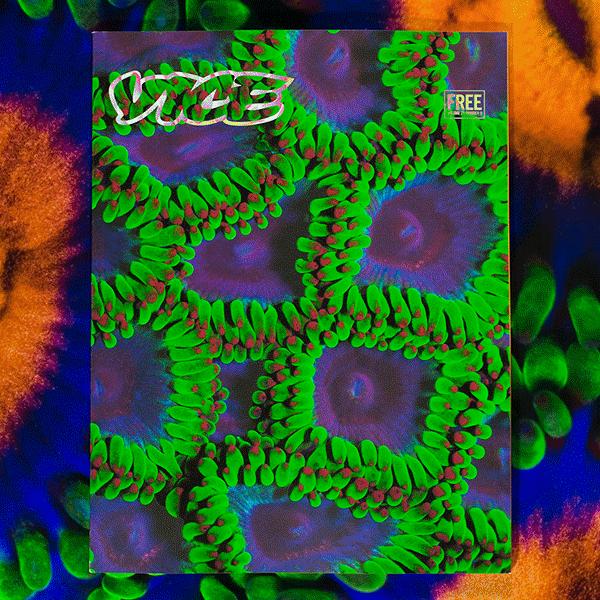
A morphing loop of ‘The Humongous Fungus Among Us Issue’ photographed under daylight, blacklight, and fluorescence filter.
Be sure to pick up a copy of the August, 2014 offering from VICE Magazine, ‘The Humongous Fungus Among Us Issue’, which features a special blacklight-reactive cover depicting Zoanthus polyps cloned and photographed in the Coral Morphologic lab. The issue’s contents are also available online, including the cover story, ‘Miami Is Drowning‘, by John McSwain.
Having been preoccupied with the Miami Coral Rescue Mission this summer, we finally made our first excursion to the Lower Keys this summer on Friday August 22. Sadly, we found that a distressingly high percentage of corals living on the reefs in Hawk Channel are severely bleached. Most of the staghorn corals that we saw were severely bleached or actively dying, though there were a few hardy exceptions. Nearly all of the brain corals were bone white. All over the reef we observed an unhealthy mix of cyanobacteria and algae proliferating on previously dead coral skeletons. Even the normally hardy gorgonians, corallimorphs, and zoanthids showed significant bleaching on all three patch reefs we checked. The water temperature was an uncomfortable 89 degrees on the bottom. Without strong winds or storms to cool off the water, we are concerned that many reefs in the Keys will lose significant coral cover in the next several months.
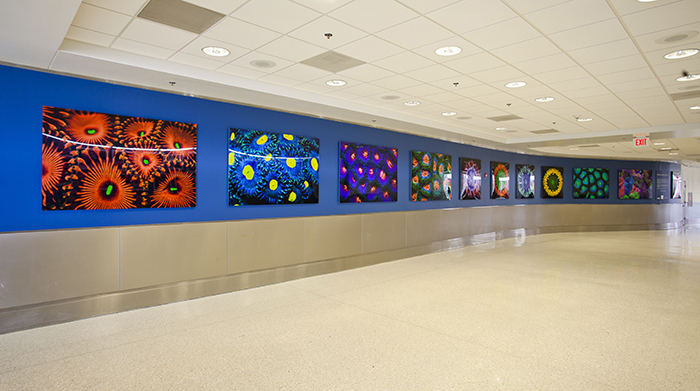
Flower Animal exhibition at Miami International Airport, 2014. Photos: Oriol Tarridas.
We are proud to share that Miami International Airport/ MIA Galleries has unveiled an 80-foot spread featuring selections from our local marine life photography collection, Flower Animal. The exhibition is comprised of eleven metallic-paper, diasec-mounted prints, and is located in the Concourse D.
Update 2018: As of 2018, Flower Animal now resides in Concourse E/ International Arrivals.
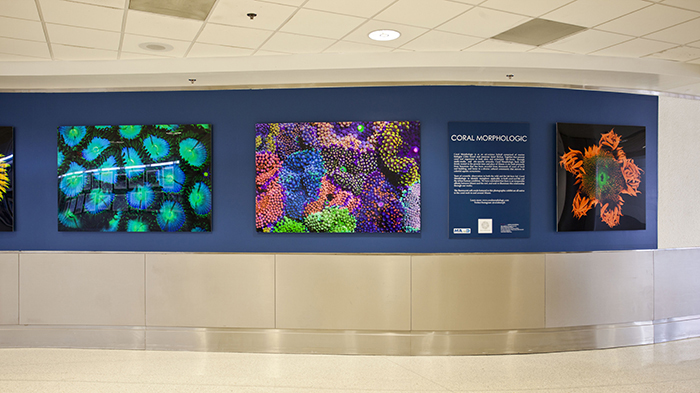

A Coral Reef City vinyl-wrapped parking booth at PortMiami, 2014. Photo: Gesi Schilling.
Earlier this year we teamed with artist and friend Bhakti Baxter to wrap 18 parking booths at PortMiami with colorful vinyl, vividly depicting portraits of Miami’s now-iconic soft corals, Zoanthids. Coral Reef City was commissioned by Miami-Dade Art in Public Places and will remain at the port through 2024, welcoming 4 million visitors annually.
Update 2015: We are honored to announce that the project was awarded among the best public art projects in the nation by Americans for the Arts as part of their Public Art 2014 Year in Review.
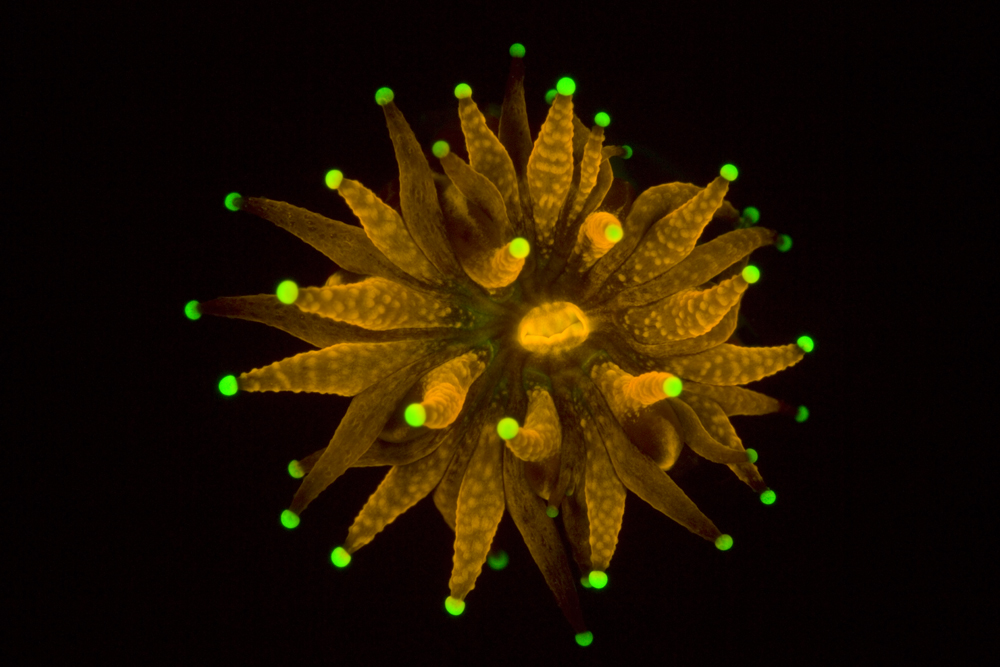
A hyper-fluorescent juvenile Montastrea cavernosa rescued from Government Cut.
After months of impatiently watching dredge ships working offshore Miami, Coral Morphologic and other researchers were finally granted a brief window of opportunity from May 26 until June 6th in which to rescue corals left behind from the legally-required relocation effort from the Army Corps of Engineers’ Deep Dredge of Government Cut. This was a much shorter length of time than we had been prepared for, and as such, we had to respond with considerable urgency in order to rescue as many corals as possible. Fortunately we had begun our detailed preparations in January 2014 by coordinating students and professors from the University of Miami to help in the effort. Collectively, the Miami Coral Rescue Mission removed over 2,000 stony corals that would have otherwise been destroyed in the process to make way for the larger ships that will pass through the soon-to-be-expanded Panama Canal.
The majority of the corals that Coral Morphologic removed from Government Cut have now been transplanted to an artificial reef about one mile south from where they originated, and where we will continue to monitor them to ensure their long-term survival. Some corals will be sent to the Smithsonian Institution for research. And the rest of the corals were brought back to our Lab, where we will document them via film and photography for a body of work titled ‘Coral City’, in which we will present them as fluorescent icons for a 21st century Miami.
While we could have rescued more corals with an extended deadline, the Miami Coral Rescue Mission is not over. It is now entering a longer-term monitoring phase in which we will continue to assess the health of surrounding coral reefs through July 2015, when the Deep Dredge project is finally slated for completion.
Read a New York Times article on the rescue mission and listen to an NPR story below covering a day out on the water. Click the link below the NPR story to read the remainder of this post.